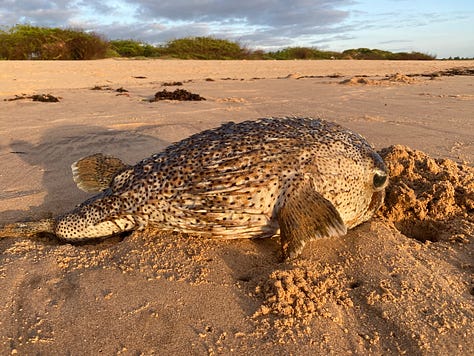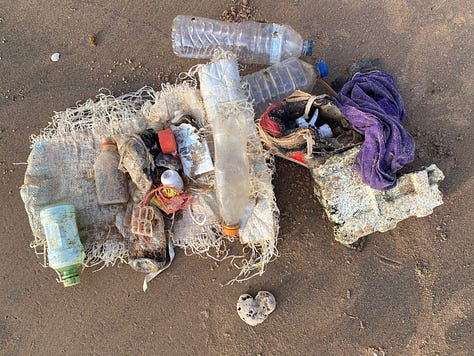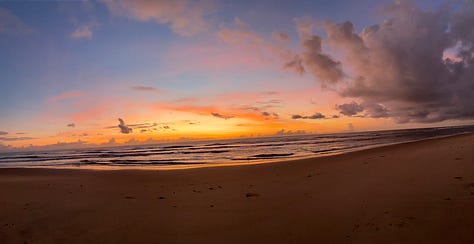Clara woke up early. She padded down the stairs and found me at the kitchen table writing. She was wearing her hand-me-down bear pajamas from her friend Zoe, a furrowed brow, and a deep frown.
“My neck hurts,” she said. She leaned into me.
I folded her into my arms and gently massaged her neck. I pulled her into my lap.
My cursor blinked on the screen.
“What are you writing about?” she asked.
I laughed. Nothing like your kiddo straight out of bed wanting you to distill your thinking when it’s 6:13am.
“I’m writing about if it’s better to help a lot of people a little bit or to help a few people a lot,” I told her. And then I asked, “What do you think?”
“I think it’s better to help a lot of people a little bit,” she answered with a 6-year old’s conviction.
“Why do you think that?” I asked.
“Because then the other people won’t feel left out.”
Sea lion
In college I went to Marin headlands one day with a couple of friends. We walked along and let the cold Pacific water lap our toes, not daring beyond our lower calves. As we hiked along the beach, over rocky shoulders and into coves, we picked up beautiful stones and looked for shells. We saw giant kelp washed ashore, which I remember having slimy, feather-like fronds, thick, rubbery tube walls, and bulbous roots (if that’s what the “bottom” of kelp is called…).

We made our way into another cove and found a sea lion beached on dry land, covered in sand. We approached – as-surely-we-shouldn’t-have-but-it-was-obviously-the-only-thing-to-do – to look for signs of life. Besides the sand, her body looked full and healthy. No obvious wounds. As we got close, I walked toward her muzzle, caked and dried. My heart sank. I crouched. She opened two giant orb doe eyes and looked straight at me unblinking. My own eyes widened and locked on hers. “Help,” she feebly pleaded. I stayed there for a minute, transfixed in her gaze. My friends and the ocean and everything faded away. I looked with (not a typo!) her a moment (minute?) longer. I resisted stroking her nose.
And then I stood up and went into mama-bear-first-responder mode.
“We need to get her back into the water.”
My friends nodded.
We knew enough not to touch her (though apparently not enough to stay 50 yards away as the Marine Mammal Center advises. My own muzzle wasn’t quite touching hers but close). Practically speaking, she probably weighed hundreds of pounds so even if we could get our hands on her slippery flesh to drag her back to the sea we likely wouldn’t have been successful and that seemed like it would be traumatic for her. And us. There was no way to call for help (back before cell phones) and here we were with an animal who we believed would die without our intervention. We surveyed the scene, searching for any resources to aid in her rescue.
Our eyes scanned the shoreline. Sticks. Rocks. More rocks. Kelp!
We set about fashioning a kelp rope, tying a few strong pieces together so we could drag her without being too close. We laid our rope in a horseshoe shape around her and with two of us on one side and one on the other we slowly dragged her toward the water, wedging the kelp cord under her body, keeping our own bodies low to the ground so the rope wouldn’t flip out from beneath her. Progress was slow, but our rope held. Her body skidded through the sand. I hoped we weren’t hurting her, but she didn’t fight it. Perhaps she was too far gone.
I wanted to pick her up, hold her, comfort her, and carry her to wherever she wanted to go (if she wanted to go — thoughts of her agency and possible decision to ‘go somewhere to die in peace’ — flashed through my mind).
I remember discussing if we should drag her all the way into the sea or just close to it so she could re-acclimate to the liquid world without having to immediately swim. We had no idea how long she had been stranded before we came. We had no idea what we were doing. Or if we were helping. Or hurting. We were acting on instinct.
This will feel anticlimactic, but I honestly don’t remember what we decided. I think we dragged her as far as the edge of the wet sand – the tide was coming in – and then we left, the question “made a difference for that one?” reverberating in our brains.
Starfish
You’ve heard the starfish parable, right? The one where there are starfish strung along the beach as far as the eye can see, all stranded on land above the high tide line. One person walks along, picking up the drying-dying starfish one-by-one, and throwing them back into the ocean. A bystander seeing this effort and the magnitude of the problem says something like, “But the problem is too big. That won’t make a difference.” And the starfish rescuer tosses another back into the water and says, “Made a difference for that one.”

The starfish story – making a difference for one starfish among thousands – is painfully ironic since my family’s most recent beach experience was at the Indian Ocean in Malindi, Kenya where we saw plastic trash as far as the eye could see and found just one starfish safely (for the moment) ensconced in a baby-bathwater-warm tide pool.
I spent every morning during our two weeks at the coast walking along the beach before the heat became too much. While I walked, I listened to podcasts, and picked up trash. I watched the sunrise over the ocean. I felt the breeze. I observed fishermen with their nets and wondered how viable their industry is now. I saw several young men running along the beach carrying a fish in one hand, off to make breakfast for their family, I imagined. I found a dead puffer fish not yet dissected by scavengers. His eyes (no idea if he was a he, but he seemed like a he) were glassy bulbs. We would have no opportunity for connecting in this life.



Other beach walkers I passed while carrying my bags of trash said things like “What difference will it make?” and “Tomorrow it will be the same,” gesturing to trash all around us. I grimace-smiled, shrugged my shoulders, and plied on. I thought of the sea turtle at the Local Ocean turtle rescue facility we visited. She floated listlessly, waiting for laxatives to flush out the trash she had ingested – plastic-bag balloons lacing her digestive tract – that prevented her from swimming below the surface and finding food.
There’s no talk of “a difference for that one” when “one” is a piece of trash.
But one is also a turtle. And one is me. So there’s that.
Theory of Change
I often think of the starfish parable when I think of my theory of change for mainstreaming apple-a-day nature-based learning. Which also happens to be the theory of change that underscores my non-profit’s (Good Natured Learning1) work. I think about doing a lot for a couple of people (i.e. throwing a few starfish back into the ocean and saving them) versus doing a little for a lot of people (i.e. doing something for all of the starfish pearling the fabled shore).
While telling my new friend Pius about what Good Natured Learning does, I explained our theory of change thusly:
1.5 billion students and 81 million teachers spend up to 20% of their waking hours in schools around the planet.
Less than 1/1000 of that time is spent connecting with nature. For many students the number is an unconscionable, gaping 0.
Human-nature connections are good for humans and the planet.
Human-nature connections can be fostered in schools during the school day through apple-a-day nature-based learning2
Teachers – by teaching – using mostly skills they already have – can forge these nature-connections — administering “nature medicine” — by teaching and becoming healers for their students, themselves, and the planet.
I carried on, as I do when I have a fire under my ass about something, which I do about this.
Apple-a-day nature-based learning can be integrated into core teaching practices by EVERY teacher, for EVERY student, in EVERY school, EVERYWHERE on the planet. It is agnostic to age, curriculum, school model, environment. It is at once universal and hyperlocal. It is infinitely variable and can be innovated and adapted by individual teachers within their locus of control and based upon their unique strengths, their community, their students, and their place.
It is a proven, low-cost, attainable, and immediate way to support all.of.the.starfish a little bit. And thereby support the whole ecosystem. The whole planet.
Subversive
There’s more, though.
I am confident that apple-a-day nature-based learning has the potential to support all students, teachers, and the planet a little bit. Which I believe adds up to a lot. Which is enough.
But what can I say to those who want transformation? Revolution?
I hear you! Just as I had to help that sea lion, I’m intrinsically drawn to revolutionizing or transforming things that are broken (which many could – and do! – compellingly argue is the current state of our education system across the globe). Still, when it comes to my theory of change, I stopped bandying about “transform” and “revolutionize” months ago. I started to feel funny-gut about them. Dishonest even.
I have benefited in my life from what are undeniably transformational experiences in days-and-nights-under-skies-Capital-N-Nature - aka “Big Nature” (wrote about that before). I cannot imagine who I would be without spending weeks rocking in the cradle of a canoe, looking at the curvature of the earth on the horizon – if I had not seen the northern lights – if I had not walked for miles trying to find a place to cross a raging, frigid river to evacuate a very sick camper – if I had not shouldered my food and shelter in the humbling hummocks and tussocks and willow thickets along the valley floor in Alaska’s mountains – if I had not, once, been bluff charged by a mama grizzly bear, the dust from her skid through the gravel kicking up in my face. These Big Nature experiences transformed me. They made a difference for this one.

But these days I just can’t stop seeing how my story is about just one really freaking fortunate starfish – me – tossed back to an incredible sea while others are left above high tide with nothing. And that just won’t work because we all need to feel connected to more-than-human nature. Not just one of us. Every human having a relationship with more-than-human nature is the only way. I’m convinced.
So at face value, my theory of change boils down to Clara’s answer this morning. I’m about mainstreaming apple-a-day nature-based learning – routine, modest, bite-sized, nature-connections – providing an ounce of seawater for every metaphorical starfish stranded above high tide in our schools right now. About elevating everyone’s – and our planet’s – baseline wellness.
But there’s a more subversive element to my theory of change – in the goodest trouble definition of subversive.
Apple-a-day nature-based learning works at all levels of fidelity.
Some low-fi teachers will put a plant in their classroom or hang up some images of nature on their walls. And that’s it. And those micro-changes will make themselves and their students just a little bit better than before. Which is infinitely better than nothing.
Some medium-fidelity teachers will teach their students outdoors. They will feel the breeze on their skin and watch fluttering leaves on a tree. Nature will offer invitations. And students’ curiosity will drive questions. And deeper learning. This is a substantive shift. After all,
Students will never wonder about a bird they can’t see fly by.
And then we have the high-fidelity teachers – the ones who integrate apple-a-day nature-based learning indoors and outdoors – and who say “yes” to nature’s invitations. Following their students, they start wondering – and wandering – beyond their classroom and curriculum and school’s artificial boundaries. The become better teachers facilitating and guiding inquiry-based, relevant, student-driven learning.
That, my friends, is transformational, and I don’t even feel funny saying it.
This morning, I presented Clara with a false dichotomy – help a lot of people a little bit or help a few people a lot.
Yes.
That’s my theory of change. I’ll follow-up with her about this soon.
❤️B
Note - I am aware that our website needs some work. Among other things…
Apple-a-day nature-based learning is learning that includes routine, modest, “bite-sized” nature connections.



While waiting/working for revolution, transformation, innovation (fill in the “tion”), eat an apple a day…